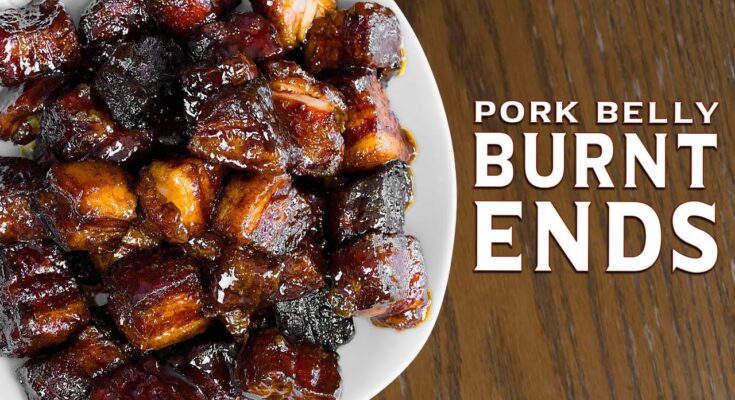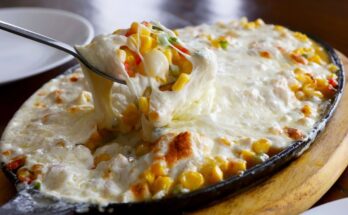Burnt Ends Recipe: Burnt ends are the flavorful, smoky, and caramelized pieces of meat typically cut from the point end of a smoked brisket. Known for their tender, melt-in-your-mouth texture and rich barbecue flavor, burnt ends have become a staple in American barbecue cuisine. Often referred to as “meat candy,” these bite-sized pieces pack a perfect balance of smoky, sweet, and savory flavors.
Whether served as an appetizer, main course, or a side dish, burnt ends are guaranteed crowd-pleasers at any gathering. But their rise to fame wasn’t instant—it was a happy accident that turned leftovers into a delicacy.
The History of Burnt Ends
Burnt ends originated in Kansas City, where pitmasters would trim off the charred edges of brisket during preparation. Initially discarded or handed out as samples, these trimmings gained popularity due to their intense flavor and crispy texture. Soon, restaurants started serving them as a specialty, and they quickly became a barbecue sensation across the United States.
Ingredients Needed for Burnt Ends
Meat Selection: Choosing the Right Cut
The foundation of great burnt ends is the meat. Traditionally, brisket is the go-to cut, specifically the point end, which has a higher fat content compared to the flat end. This marbling ensures a juicy and tender result after hours of slow smoking.
Alternative Options:
- Pork belly for a rich, fatty variation.
- Chuck roast for a more affordable option.
- Beef short ribs for bite-sized, smoky treats.
Essential Seasonings and Rubs
A good rub enhances the flavor profile of the meat, creating a crusty bark during smoking. Here’s a basic dry rub recipe:
- Brown Sugar – Adds sweetness and caramelization.
- Paprika – Provides color and smoky undertones.
- Garlic Powder – Enhances savory notes.
- Onion Powder – Adds depth to the flavor.
- Black Pepper and Kosher Salt – Essential for seasoning.
- Cayenne Pepper – Optional, for a spicy kick.
For the sauce, you’ll need:
- Barbecue sauce (your preferred brand or homemade).
- Honey or maple syrup for added sweetness.
- Apple cider vinegar for tanginess.
- Hot sauce, if you like it spicy.
Tools and Equipment Required
Must-Have Grilling and Smoking Tools
- Smoker or Grill with a Smoking Setup – Key for slow cooking and infusing smoky flavor.
- Meat Thermometer – Ensures the meat reaches the ideal internal temperature.
- Sharp Knife – For precise trimming and cubing.
- Cutting Board – Preferably with a juice groove to catch drippings.
- Tongs and Grill Gloves – For handling hot meat safely.
Optional Tools for Enhanced Results
- Spray Bottle – For misting the brisket with apple juice or broth to maintain moisture.
- Wood Chips or Chunks – Hickory, oak, or cherry wood for rich smoky flavors.
- Foil or Butcher Paper – For wrapping the brisket during smoking.
- Basting Brush – For applying sauce evenly.
Preparing the Brisket
Trimming the Brisket for Burnt Ends
Before smoking, trim excess fat from the brisket, leaving about ¼ inch of fat cap for flavor and moisture. Removing silverskin and hard fat ensures even cooking and better absorption of seasoning.
Steps to Trim:
- Place the brisket flat-side down on a cutting board.
- Use a sharp knife to remove thick, hard fat deposits.
- Trim thin, loose edges to avoid burning.
- Shape the brisket into a uniform form for consistent cooking.
Applying the Dry Rub
Generously coat the brisket with the prepared dry rub. Massage it into every crevice to form a solid crust.
Tips for Maximum Flavor:
- Apply mustard or oil as a binder before adding the rub.
- Wrap the brisket in plastic wrap and let it marinate overnight in the refrigerator.
- Allow the brisket to rest at room temperature for 30–60 minutes before smoking.
Smoking the Brisket
Setting Up the Smoker
Preheat the smoker to 225°F (107°C), maintaining low and slow heat. Add wood chunks or chips for smoke flavor. Popular choices include:
- Hickory – Bold and rich flavor.
- Oak – Mild and versatile.
- Cherry or Apple – Fruity and slightly sweet.
Water Pan Tip: Place a water pan in the smoker to regulate temperature and keep the meat moist.
Smoking Techniques and Temperature Control
- Place the brisket fat-side up on the smoker grate.
- Smoke until the internal temperature reaches 165°F (74°C)—this may take 6–8 hours.
- Mist the brisket every hour with apple juice or broth to maintain moisture.
Creating the Burnt Ends
Cutting the Brisket into Cubes
Once the brisket has reached an internal temperature of 165°F (74°C) and developed a beautiful bark, it’s time to transform it into burnt ends. Start by carefully removing the brisket from the smoker and placing it on a clean cutting board.
Steps to Cube the Brisket:
- Allow the brisket to cool slightly for easier handling.
- Slice off the point end of the brisket, as this part has more marbling and fat, which is perfect for burnt ends.
- Cut the meat into 1-inch cubes for consistent size and even cooking.
Pro Tip: Save the flat end of the brisket for slicing and serving separately—it makes delicious sandwiches!
Adding Sauce and Seasoning
To elevate the flavor, toss the brisket cubes in a savory, sticky sauce that complements their smoky profile.
Steps for Sauce and Seasoning:
- Place the cubes in a disposable aluminum pan or foil tray for easy cleanup.
- Coat them generously with barbecue sauce, ensuring each cube is covered.
- Sprinkle an additional layer of dry rub for extra seasoning and caramelization.
- Add a drizzle of honey or brown sugar for a sweet glaze that balances the smokiness.
Let the cubes rest for 5–10 minutes to allow the flavors to soak in before returning them to the smoker.
Cooking Burnt Ends to Perfection
Slow Cooking for Flavor Infusion
Now it’s time to let the smoker work its magic again. Set the temperature to 225°F (107°C) and return the pan of sauced cubes to the smoker.
Cooking Process:
- Cover the pan loosely with foil to retain moisture during the first 30 minutes.
- After 30 minutes, remove the foil to allow the sauce to thicken and the cubes to develop a sticky, caramelized crust.
- Stir the cubes occasionally to ensure even cooking and sauce distribution.
The burnt ends are ready when the internal temperature reaches 195–205°F (90–96°C) and they are tender enough to melt in your mouth. This process usually takes 1–2 hours.
Checking for Doneness
Wondering how to know when your burnt ends are done? Look for these signs:
- Tenderness: The meat should be fork-tender but not falling apart completely.
- Appearance: A glossy, caramelized coating with slightly crispy edges.
- Smell: Smoky, sweet, and savory aromas that make your mouth water.
If you’re unsure, use a meat thermometer to double-check the temperature before removing the pan from the smoker.
Resting and Serving Burnt Ends
Resting Time for Juicy Results
Let the burnt ends rest for about 10–15 minutes after removing them from the smoker. This short resting period allows the juices to redistribute within the meat, ensuring each bite is tender and flavorful.
Why Resting is Important:
Skipping this step could lead to dryness, as cutting into hot meat causes the juices to escape. Resting preserves the moisture inside.
Presentation and Serving Ideas
Burnt ends are versatile and can be served in various ways:
- Appetizer: Serve them on skewers or toothpicks as finger food at parties.
- Main Course: Pair them with creamy mashed potatoes, coleslaw, or cornbread for a hearty meal.
- Sandwiches: Stuff them into a toasted bun with pickles and extra barbecue sauce.
- Tacos: Use them as a taco filling with slaw and spicy aioli.
Garnishing Tip: Sprinkle chopped parsley or green onions for a pop of color and freshness before serving.
Tips for Perfect Burnt Ends Every Time
Avoiding Common Mistakes
- Overcooking: Keep an eye on the temperature to prevent the meat from drying out.
- Underseasoning: Don’t skimp on the rub and sauce—bold flavors are key.
- Inconsistent Sizes: Cut uniform cubes to ensure even cooking.
- Skipping Rest Time: Always let the meat rest before slicing or serving.
Enhancing Flavor with Custom Rubs and Sauces
Experiment with different flavors by adjusting the rub or sauce. Here are a few ideas:
- Spicy Burnt Ends: Add cayenne, chili powder, or hot sauce for heat.
- Sweet Burnt Ends: Mix honey or molasses into the sauce for a sugary glaze.
- Savory Burnt Ends: Use Worcestershire sauce and garlic powder for a more umami-packed flavor.
Variations and Alternatives to Brisket Burnt Ends
Pork Belly Burnt Ends
For a fattier and richer alternative, try pork belly burnt ends. These have a similar texture but with even more juiciness due to the high-fat content.
Steps:
- Cube the pork belly into 1-inch pieces.
- Season with your favorite dry rub.
- Smoke at 225°F (107°C) for 2–3 hours until tender.
- Toss in sauce and cook for another hour until caramelized.
Vegetarian Options
Surprisingly, vegetarians can also enjoy the flavors of burnt ends. Try using smoked tofu or cauliflower florets for a plant-based twist. Season and roast them similarly to mimic the texture and flavor profile.
Pairing Burnt Ends with Side Dishes
Best Side Dishes to Serve
Burnt ends are rich, smoky, and flavorful, so pairing them with the right sides can create a well-balanced meal. Here are some classic and creative options:
- Coleslaw – A creamy or vinegar-based coleslaw adds a refreshing crunch and balances the smoky flavor of burnt ends.
- Macaroni and Cheese – Creamy, cheesy mac and cheese is a comfort food favorite that complements the smoky sweetness of burnt ends.
- Cornbread – Slightly sweet and crumbly cornbread serves as a perfect companion, especially when topped with honey butter.
- Baked Beans – Smoky and slightly sweet baked beans enhance the barbecue flavor and add richness to the meal.
- Potato Salad – A chilled potato salad with a tangy dressing provides a cooling contrast to the heat and spice of the meat.
- Grilled Vegetables – Lightly charred veggies like zucchini, bell peppers, and asparagus offer a healthy balance.
- Pickles and Pickled Onions – Their tangy flavor cuts through the fat, refreshing the palate.
Drink Pairings for Burnt Ends
The bold flavors of burnt ends call for beverages that can hold their own:
- Beer – A hoppy IPA or a smoky porter complements the charred edges perfectly.
- Bourbon – Its caramel and smoky notes make it an excellent match for barbecue.
- Iced Tea – Sweet or unsweetened tea provides a refreshing, non-alcoholic pairing.
- Lemonade – The tangy sweetness of lemonade balances the savory flavors.
- Red Wine – A full-bodied red like Zinfandel pairs well with the rich flavors of burnt ends.
Nutritional Information and Serving Size
Calories and Macronutrients
While burnt ends are undeniably delicious, they are also rich in calories and fat due to the marbling in the brisket and the added sauce.
Estimated Nutritional Breakdown (Per 4 oz serving):
- Calories: 300–400 kcal
- Protein: 25–30 g
- Fat: 20–25 g
- Carbohydrates: 15–20 g (depends on sauce)
Adjusting Portions for Different Diets
- Low-Carb/Keto: Use a sugar-free barbecue sauce or skip the sauce altogether, relying on the rub for flavor.
- Low-Fat Options: Opt for leaner cuts of meat, like chicken thighs, instead of brisket.
- Vegetarian Alternatives: Replace brisket with roasted cauliflower or portobello mushrooms and use plant-based sauces.
Storage and Reheating Tips
Proper Storage Techniques
Burnt ends can be made in advance and stored for later enjoyment. Here’s how:
- Refrigeration: Place leftover burnt ends in an airtight container and store them in the refrigerator for 3–4 days.
- Freezing: For longer storage, freeze them in a vacuum-sealed bag or airtight container for up to 3 months.
Reheating Without Drying Out
Reheating burnt ends properly ensures they stay tender and flavorful:
- Oven Method: Preheat the oven to 275°F (135°C). Place the burnt ends in a foil-covered pan with a splash of broth or sauce to keep them moist. Heat for 15–20 minutes.
- Microwave: Place them in a microwave-safe dish, cover with a damp paper towel, and heat in 30-second intervals.
- Stovetop: Warm them in a skillet over medium heat, adding extra barbecue sauce if needed.
- Grill or Smoker: Reheat them directly on the grill or smoker at 225°F (107°C) for 10–15 minutes to restore their smoky flavor.
FAQs about Burnt Ends Recipe
What are burnt ends?
Burnt ends are flavorful pieces of meat cut from the “point” half of a smoked brisket. These small chunks or ends are known for their rich, charred exterior and tender, juicy inside. Traditionally associated with Kansas City barbecue, burnt ends are a delicacy in many barbecue establishments.
How do I make burnt ends?
To make burnt ends, start by smoking a whole brisket until it reaches an internal temperature of about 195°F. Separate the point from the flat, then cut the point into cubes. Return these cubes to the smoker or grill, coat with additional barbecue sauce, and continue to cook until they are caramelized and crispy on the outside.
What temperature is best for cooking burnt ends?
The ideal cooking temperature for burnt ends in a smoker or grill is around 225°F to 250°F. This low and slow approach allows the fat to render properly, ensuring that the meat remains moist and tender while achieving a crispy exterior.
Can I make burnt ends using other types of meat?
Yes, while traditional burnt ends are made from beef brisket, you can also make them using pork belly or even chuck roast for a different twist on the classic recipe. The key is to choose a fatty cut of meat that can withstand the long cooking process without drying out.
What should I serve with burnt ends?
Burnt ends are often served with classic barbecue sides such as coleslaw, baked beans, and cornbread. They also pair well with pickles and onions to cut through the richness of the meat.
How long do burnt ends take to cook?
The cooking time for burnt ends can vary, but generally, you should plan for at least 3 to 4 hours of smoking the brisket, followed by an additional 1 to 2 hours after cubing and returning the meat to the grill to achieve the perfect caramelization.
Can burnt ends be reheated?
Yes, burnt ends can be reheated and still retain much of their flavor and texture. For best results, reheat them in an oven at a low temperature, covered, to prevent them from drying out.
Conclusion
Whether you’re a seasoned pitmaster or a beginner experimenting with smoking techniques, this step-by-step guide ensures your burnt ends turn out flawless every time. From selecting the right meat to mastering the rubs and sauces, you now have everything you need to create this barbecue masterpiece.
So fire up your smoker, gather your tools, and prepare to impress your guests with the ultimate burnt ends recipe. Happy smoking!



